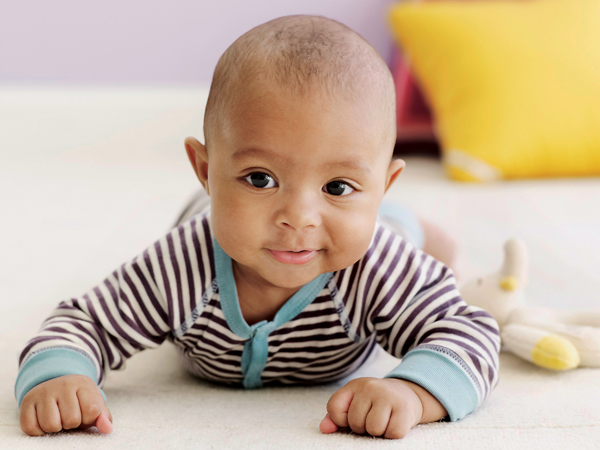Track star

It’s remarkable how much an infant changes and grows in […]
It’s remarkable how much an infant changes and grows in the first year of life. On day one, you’ll have in your arms a fairly unexpressive, stationary lump of wonder; by day 365, that little one will be smiling, laughing and making her way around the room all on her own. How she’s making her way, however, might differ from one child to another because while some kids will be toddling steadily on their feet by this point, others will still be traveling via hands and knees.
“All babies develop at their own pace,” says Chrystal de Freitas, MD, pediatrician in San Diego. “There are guidelines that pediatricians keep in mind, but there are also broad margins of when these milestones can be reached.” Some tots might take that first timid step around 9 months of age, but for others it could be more like 15 months—and both are considered normal.
It can be easy to panic when your tot is the last of her peer group to master a task, but it typically isn’t any cause for concern. There are well-established milestones that babies evolve through during their first year of life, explains de Freitas, but exactly when a child hits each milestone is less important than the pattern of evolution in which she moves through them.
So how do you know when it’s time to worry about a missed marker? Although mother’s instinct shouldn’t be discounted, your pediatrician is your best source for monitoring baby’s development. “Keeping track of these milestones is one of the many reasons for well-child visits,” notes de Freitas. And although a delayed accomplishment isn’t necessarily a sign of trouble, certain factors—typically those relating to cognitive and social development—might raise a red flag for further investigation.
Movement
Initially, your wee one won’t have much head control, but she will be able to turn toward the breast and root around in search of a meal. Her tiny fists will stay tucked in close to her body and face.
In time, she’ll begin to open and close her hands and stretch out her body a bit. She’ll discover that she has some control over her limbs, and her movements will gradually become more fluid. As her head becomes less wobbly, she’ll realize that she can raise it—and her chest—while lying on her stomach, eventually gaining the strength to support her upper body with her arms.
From there, baby will begin working out how to roll over, typically from tummy to back first and later from back to tummy. She’ll then figure out how to work her knees underneath her body; this skill is necessary for her to move herself into an unassisted sitting position. She’ll evolve from there to an all-fours position and begin rocking back and forth, which leads to crawling—or, at least, some form of movement that loosely resembles crawling.
Some begin with an army crawl, dragging the lower body along for the ride. Some crawl backward. Some adopt an odd scoot that allows them to get from point A to point B. If your baby isn’t a traditional hands-and- knees mover, it’s A-OK.
After crawling, baby will learn to pull up to a standing position and “cruise” the room with the assistance of furniture. She’ll eventually let go and learn to stand on her own, and from there it’s only a matter of time before those little feet start stepping. Whether it happens before or after that first birthday, your life will never be the same!
Sensory and cognitive
Initially baby’s eyesight will be hazy, but she can see you from the minute she is born—you just have to get close. (Lean toward her face and speak softly to her; she won’t mind one bit.) Her vision will steadily improve, and by about the 2-month mark she’ll see well enough to take in faces and follow objects (and people) with her eyes. Baby’s sight develops gradually but should be fully matured somewhere between 6 and 8 months.
Hearing develops in a much shorter span —it’s fully acquired within the first month outside the womb—and baby will almost immediately startle in response to loud noises. Recognition of voices happens quickly as well; in fact, your tiny bambino will know your voice upon arrival. (She’s been hearing it in the womb for several months.) Almost as soon as she has head control, she’ll begin to turn her head toward sounds to locate where they’re coming from.
As baby’s brain develops, so too will her motor skills. She’ll gain control of her hands, learning first to grasp a toy and then to pass it from hand to hand. She’ll swing at dangling toys and shake rattles (and not just accidentally). Eventually, she’ll use her tiny fingers to point and be able to pick up small items between her thumb and index finger.
By age 1, most babies can “play” fairly well. She might hand you a book for a story, bang toys together to make noise, push a button for music or sounds, move items in and out of a container, and find hidden objects. (Bring on the peekaboo!)
When it comes to finding her voice, baby will start cooing and may even “talk back” in response to things you say by 3 to 4 months, says de Freitas. A couple months later she’ll begin babbling and then stringing vowels together. Consonants will follow, and she’ll try to repeat sounds back to you. Next up are simple words, like “mama” and “baba,” which she’ll begin to associate with the person or object. By her first birthday, she’ll likely also have mastered “uh-oh!” and be able to use simple gestures with (or without) her words, such as shaking her head for “no” and waving “bye-bye.”
Social
Perhaps nothing is sweeter than baby’s first smile. In the beginning grins will be unexpected and more likely related to gas or a dream than elicited from mom and dad. But soon enough, you’ll begin communicating with baby, and you’ll see bits of her personality shining through.
“By 2 months of age most babies have a social smile,” says de Freitas. “That means that if you smile at them they will readily smile back at you.” Your baby should show interest in and enjoy interaction with other people (although mom will likely always be the favorite). By the end of her seventh month, she should be able to distinguish emotions by tone of voice and respond to her name.
These types of milestones are the ones that doctors tend to be most concerned with because, as de Freitas explains, “We know that early intervention is the key to helping children within the autism spectrum disorder.” If a child hasn’t yet mastered rolling in both directions by her half-birthday but is otherwise developing on track, she might just be a bit of a late bloomer. If she isn’t reaching for toys, showing affection or responding to stimuli, that’s much more concerning.
Ultimately, babies trod along at their own pace, and while it’s important to encourage them, it’s equally important not to overthink every movement (or lack thereof). “It may be hard not to compare your baby with others of the same age,” says de Freitas, “but a healthier approach is to allow children to be individuals and unfold at their own rate of development.”







